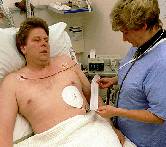
MONDAY, Nov. 28 (HealthDay News) — About one in 10 people who have angioplasty to open blocked heart arteries will land back in the hospital within 30 days, a new study indicates.
And a second, related report found that rehospitalization after angioplasty or stent placement remains a risk even three years after the procedure.
Both studies, which appear in the Nov. 28 issue of the Archives of Internal Medicine, highlight the need for better methods of identifying and treating high-risk individuals.
In the first study of more than 15,000 people who had either a balloon angioplasty or stent placement to open up their blocked heart arteries, 9.4 percent of the patients were readmitted to the hospital within 30 days. What’s more, these individuals were more likely to die within a year when compared with their counterparts who were not readmitted to the hospital after their procedure. Females, individuals with unstable angina (chest pain) and those with Medicare insurance were among the most likely to be rehospitalized after their procedure, the results showed.
“I wouldn’t have thought the rehospitalization rate would be that high, but it gives us an opportunity to study those factors that we could change,” said study author Dr. David Holmes, a cardiologist at Mayo Clinic in Rochester, Minn.
Many of the factors that increase risk of rehospitalization can’t be changed, but others can be addressed.
“Maybe people with lower education levels can’t follow instructions, so maybe we need to change how we provide information so that they go out understanding what medications they need to take and what the warning signs are that should make them come back,” Holmes explained.
“Coronary artery disease is a chronic condition that needs chronic care,” he said. “Just because a stent is placed or bypass surgery is done does not mean that you don’t need continued care in terms of preventing other episodes. You have the disease and have been treated for this episode. Now we need to treat the rest of you to decrease the chance that you will have another episode in the course of this chronic and progressive disease.”
The second study looked at the readmission rate among 11,118 patients from an Italian heart registry. After three years, they had a 7 percent to 20 percent rate of hospital readmission. The 7,867 rehospitalizations were for new procedures to open arteries, heart failure, heart attack or serious bleeds.
“Hospital admissions are frequent, both in the first year and in the following years after,” said study author Dr. Gianluca Campo, a cardiologist at the Azienda Ospedaliera-Universitaria di Ferrara in Ferrara, Italy. “The most dangerous adverse events are heart failure and bleeding events. These complications have a strong negative impact on long-term mortality.”
Earlier identification of individuals who are at high risk for readmission after angioplasty or other cardiovascular procedures is key, said Dr. Adrian F. Hernandez, a cardiologist at Duke University who co-authored an editorial accompanying the new studies. Much of this onus falls on the hospitals that treat and release these patients, he said. “Understand the holes in your system: Do you even know your readmission rates, and can you develop metrics around readmission?” he asked.
Also, “identify the barriers in transitions of care: Do patients have the right information when they walk out the door? Do they know who to call with problems? Do they have their medications? Do they have appropriate follow-up scheduled? Can they get to the appointment?,” Hernandez asked. “Follow-up ideally within seven to 10 days with a generalist or cardiologist is suitable.”
Certain factors that may place a patient at high risk for rehospitalization include having several other medical problems such as heart failure, kidney disease or lung disease. “Emergent or urgent angioplasty is also higher risk, [and] whether the procedure was considered a success or whether it was complicated may influence the risk of having problems after discharge,” Hernandez added.
“Of the variables identified as being independently associated with 30-day rehospitalization, the vast majority are not modifiable,” said Dr. Gregg C. Fonarow, associate chief of cardiology at the University of California at Los Angeles. “Further studies are needed to determine if any of the readmissions are preventable, and that preventing readmission would reduce mortality.”
More information
What is angioplasty? Find out at the U.S. National Heart, Lung, and Blood Institute.

